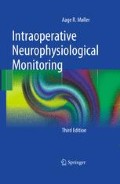Abstract
To understand why and how neuroelectric potentials, such as evoked potentials, may change as a result of surgical manipulations, it is necessary to understand the basic principles underlying the generation of such neuroelectric potentials that can be recorded from various parts of the nervous system. In this book, we discuss electrical potentials that are generated in response to intentional stimulation, and we will describe how the waveform of such recorded potentials may change as a result of injury to nerves or nuclei. It is also important to understand the nature of the responses that may be elicited by surgical manipulations of neural tissue and from surgically-induced injuries. Further, it is important to know where in the nervous system specific components of the recorded evoked potentials are generated, so that the exact anatomical location of an injury can be identified on the basis of changes in specific components of the electrical potentials that are being monitored.
Access this chapter
Tax calculation will be finalised at checkout
Purchases are for personal use only
References
Desmedt JE and G Cheron (1980) Central somatosensory conduction in man: neural generators and interpeak latencies of the far-field components recorded from neck and right or left scalp and earlobes. Electroencephalogr. Clin. Neurophysiol. 50:382–403.
Gasser H (1941) The classification of nerve fibers. Ohio J. Sci. 41:145–59.
Møller AR, V Colletti and FG Fiorino (1994) Neural conduction velocity of the human auditory nerve: bipolar recordings from the exposed intracranial portion of the eighth nerve during vestibular nerve section. Electroencephalogr. Clin. Neurophysiol. 92:316–20.
Møller AR (2003) Sensory Systems: Anatomy and Physiology. Amsterdam: Academic Press.
Møller AR (2006) Neural Plasticity and Disorders of the Nervous System. Cambridge: Cambridge University Press.
Møller AR (2006) History of cochlear implants and auditory brainstem implants, in Cochlear and Brainstem Implants, AR Møller, Editor. Karger: Basel. 1–10.
Loizou PC (2006) Speech processing in vocoder-centric cochlear implants, in Cochlear and Brainstem Implants, AR Møller, Editor. Karger: Basel. 109–43.
Møller AR (1975) Latency of unit responses in the cochlear nucleus determined in two different ways. J. Neurophysiol. 38:812–21.
Møller AR (2000) Hearing: Its Physiology and Pathophysiology. San Diego: Academic Press.
Lorente de Nó R (1947) Analysis of the distribution of action currents of nerve in volume conductors. Stud. Rockefeller Inst. Med. Res. Repr. 132:384–482.
Goldstein Jr. MH (1960) A statistical model for interpreting neuroelectric responses. Inf. Control 3:1–17.
Erlanger J and HS Gasser (1937) Electrical Signs of Nervous Activity. Philadelphia: University of Pennsylvania Press.
Møller AR, V Colletti and F Fiorino (1994) Click evoked responses from the exposed intracranial portion of the eighth nerve during vestibular nerve section: bipolar and monopolar recordings. Electroencephalogr. Clin. Neurophysiol. 92:17–29.
Kandel ER, JH Schwartz and TM Jessell (2008) Principles of Neural Science. New York: Oxford University Press.
Andersen P, JC Eccles, RF Schmidt et al (1964) Slow potential wave produced by the cunate nucleus by cutaneous volleys and by cortical stimulation. J. Neurophys. 27:71–91.
Møller AR, PJ Jannetta and HD Jho (1994) Click-evoked responses from the cochlear nucleus: a study in human. Electroencephalogr. Clin. Neurophysiol. 92:215–24.
Møller AR and PJ Jannetta (1982) Evoked poten-tials from the inferior colliculus in man. Elec-troencephalogr. Clin. Neurophysiol. 53:612–20.
Cracco RQ and JB Cracco (1976) Somatosensory evoked potentials in man: farfield potentials. Electroencephalogr. Clin. Neurophysiol. 41:460–66.
Desmedt JE and G Cheron (1981) Non-cephalic reference recording of early somatosensory potentials to finger stimulation in adult or aging normal man: differentiation of widespread Nl8 and contra-lateral N20 from the prerolandic P22 and N30 components. Electroencephalogr. Clin. Neurophysiol. 52:553–70.
Møller AR and PJ Jannetta (1984) Neural generators of the brainstem auditory evoked potentials, in Evoked Potentials II: The Second International Evoked Potentials Symposium, RH Nodar and C Barber, Editors. Butterworth Publishers: Boston, MA. 137–44.
Kimura J, A Mitsudome, T Yamada et al (1984) Stationary peaks from moving source in far-field recordings. Electroenceph. Clin. Neurophys. 58:351–61.
Jewett DL, DL Deupree and D Bommannan (1990) Far field potentials generated by action potentials of isolated frog sciatic nerves in a spherical volume. Electroencephalogr. Clin. Neurophysiol. 75:105–17.
Kimura A, A Mitsudome, DO Beck et al (1983) Field distribution of antidromically activated digital nerve potentials: models for far-field recordings. Neurology 33:1164–9.
Lueders H, RP Lesser, JR Hahn et al (1983) Subcortical somatosensory evoked potentials to median nerve stimulation. Brain 106:341–72.
Stegeman DF, A van Oosterom and EJ Colon (1987) Far-field evoked potential components induced by a propagating generator: computational evidence. Electroencephalogr. Clin. Neurophysiol. 67:176–87.
Lorente de Nó R (1947) Action potentials of the motoneurons of the hypoglossus nucleus. J. Cell Comp. Physiol. 29:207–87.
Author information
Authors and Affiliations
Corresponding author
Rights and permissions
Copyright information
© 2011 Springer Science+Business Media, LLC
About this chapter
Cite this chapter
Møller, A.R. (2011). Generation of Electrical Activity in the Nervous System and Muscles. In: Intraoperative Neurophysiological Monitoring. Springer, New York, NY. https://doi.org/10.1007/978-1-4419-7436-5_3
Download citation
DOI: https://doi.org/10.1007/978-1-4419-7436-5_3
Published:
Publisher Name: Springer, New York, NY
Print ISBN: 978-1-4419-7435-8
Online ISBN: 978-1-4419-7436-5
eBook Packages: MedicineMedicine (R0)

